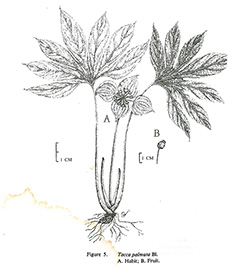e-Flora of Thailand
Volume 6 > Part 1 > Year 1993 > Page 7 > Taccaceae > Tacca
5. Tacca palmata Blumewfo-0000567900
En. Pl. Java 1: 83. 1827; Ridl., Fl. Malay Penins. 4: 309. 1924; Smitinand, Nat. Hist. Bull. Siam. Soc. 20: 61. 1961; Drenth, Blumea 20: 397. 1972; in Fl. Males., Ser. 1, Spermat. 7: 814. 1976. Fig. 5.
Accepted Name : This is currently accepted.
Description : Herb with solid tuber. Leaves 1–3, palmatisect with 5–7 segments; segments obovate or lanceolate, 10–20 by 2.5–5 cm; base attenuate along petiole; apex acuminate. Petiole 50–60 cm long. Inflorescence 1 or 2, 50–60 cm long, each up to 30 flowers. Involucral bracts 4, decussate; outer pair ovate, sessile, 3–6 by 3–5 cm, inner pair broadly ovate or cordate, petiolate, 5–7 by 3.5–5 cm. Petiole 1.5–2 cm long. Bracts absent. Pedicels 1–2 cm long. Flowers 6–17 by 5–10 mm, green to dark purple. Perianth 6-lobed; 3 outer lobes ovate, 2–6 by 2.5–6 mm; 3 inner lobes 3–5 by 2–4 mm. Stamens greenish. Ovary 2–5 by 1–4 mm. Fruit globose up to 1 cm diam. Seeds more or less pyramidal, 3–5 by 2–4 mm and 2–3 mm thick.
Thailand : SOUTH-EASTERN: Chanthaburi, Trat; PENINSULAR: Surat Thani, Nakhon Si Thammarat, Songkhla.
Distribution : Cambodia, Vietnam, Malay Peninsula, Borneo, Sumatra, Java (type), the Philippines, Celebes, Moluccas.
Ecology : In mixed deciduous and evergreen forests, 50–300 m alt. Flowering and fruiting: May–July.
Vernacular : Buk ruesi (บุกฤาษี)(Southeastern); khot din (คดดิน)(Peninsular).
Uses: The tuber has some medicinal value, and is used as poultice for fresh wounds.

